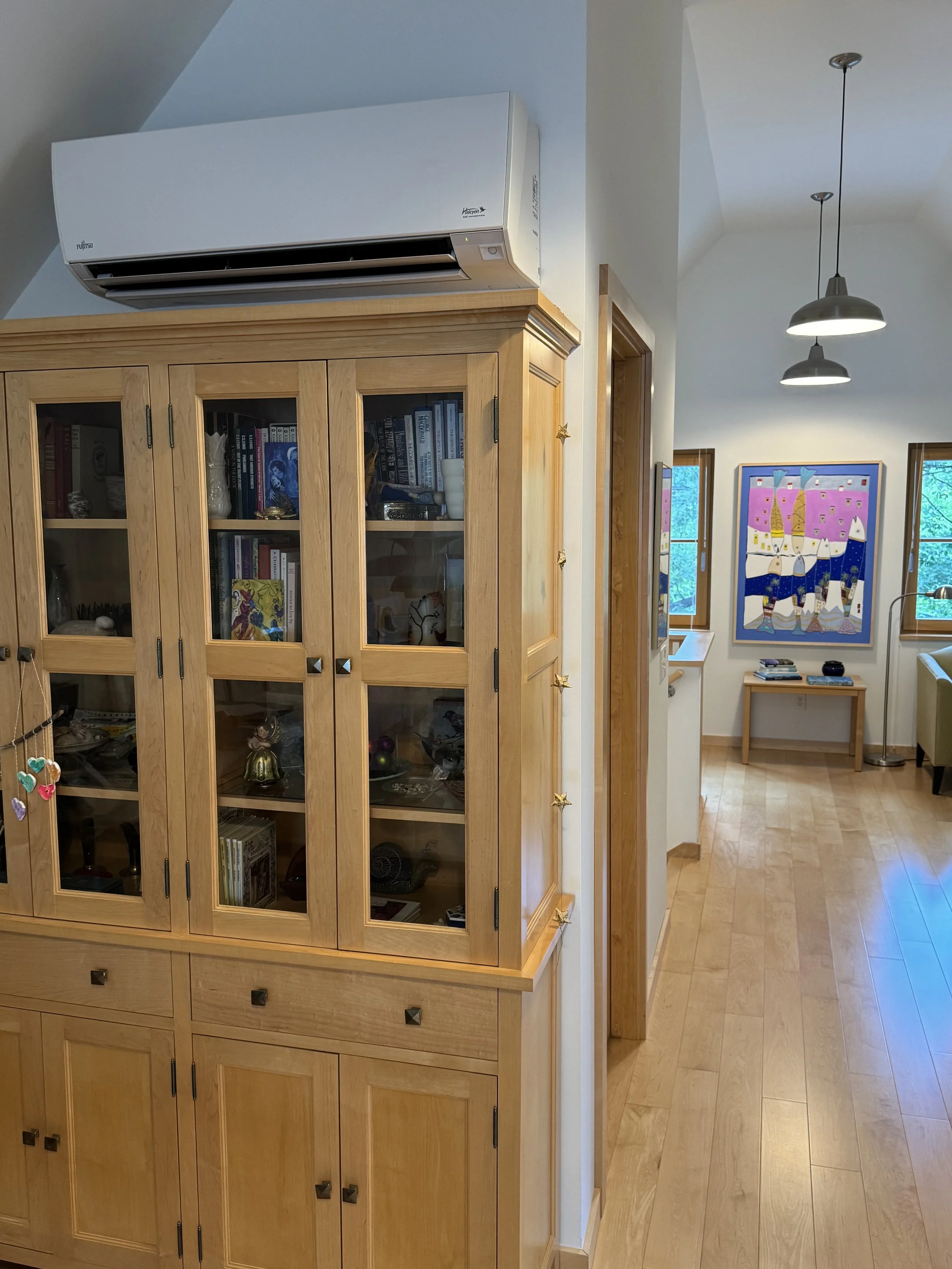Heating, Cooling & Air Quality
Heating & Cooling
The capacity of even a small 50,000 BTU furnace would overwhelm our net-zero house. Instead, two air-sourced heat pumps, called mini-splits, heat and cool our home—one on each level. We chose Fujitsu Halcyon mini-splits, as they were the most efficient units on the market at the time.
Second level mini-split.
Each mini-split is 36” long, 9” tall, and 7” deep and is mounted high on a central wall on both levels of the house to independently distribute heating or cooling. The very quiet units have remote control thermostats that provide adjustable fan speeds and modes—fan only, heat, cooling, and dehumidification—and maintain an even temperature within 2 degrees throughout the building.
Each mini-split runs off a 20-amp electrical circuit. Compressors for each unit are outside, attached to our east wall, and independently cycle each unit's fan on and off to satisfy the demand for heating or cooling. The units operate less efficiently as the winter temperatures drop, so around 15°F we supplement the mini-splits with one 400-watt ceramic wall panel and/or two Envi 500-watt convection electric wall-hung heaters. The house is so well insulated that it’s easy to maintain our desired 74°F ambient inside temperature, even on the coldest winter days.
HRV: The Lungs of the House
Healthy indoor air quality is imperative in such a tightly sealed house. Our heat recovery ventilator (HRV), the Zehnder ComfoAir 350, acts as the home’s lungs, operating continuously to provide balanced ventilation. The system operates remarkably well at around 84% efficiency (as tested by the Passive House Institute). During our freezing winters, the HRV takes the energy (heat) out of the outgoing stale air and transfers that 84% heat to the incoming fresh air before being distributed throughout the house.
Considering its many parts, the HRV’s installation was straightforward. Our system begins with two insulated graphite-infused 6-inch EPS foam pipes, which are installed through the exterior wall—one to supply fresh air and one to exhaust stale air. These pipes minimize condensation and connect to an air-to-air heat exchanger housed in the second-level mechanical room. Two MERV 14 filters clean the incoming air, capturing dust and pollen. Attached to the heat exchanger, a system of flexible 3-inch polyethylene plastic piping runs along floor joists and in walls, distributing fresh air and exhausting moist, stale air through inconspicuous wall and ceiling registers.
Unlike metal ductwork, the smooth interior of the pharmaceutical grade polyethylene plastic piping causes little friction, even as air flows through the longest runs. Consequently, it is extremely quiet. A small module in the first level bedroom controls the HRV’s four speeds (low, medium, high, and away), and each bathroom has a module for boosting the system to exhaust odors and moisture.
HRV Approval Hurdle
One of our project’s biggest challenges was our HRV approval process, which threatened our efficient clean-air system and delayed construction for two months.
We chose a premier European made Zehnder ComfoAir 350 and its associated ComfoTube distribution system, as it was widely accepted in energy-efficient building communities as being the best way to achieve healthy indoor air quality in a tightly sealed building. At the time of our build this HRV system was installed in over 50,000 European buildings annually, including hospitals and pharmacies, and in approximately 2,000 homes in the U.S. We had also seen this HRV installed in passive and net zero homes in Hudson, Wisconsin and four cities in Minnesota: Lanesboro, Northfield, River Falls, and Minneapolis.
We were stunned when our mechanical inspector felt unable to approve the rough-in inspection of our properly installed Zehnder system, as its piping was not yet UL listed and did not meet Saint Paul’s code requirement. The inspector’s concern was fire safety—smoke and fire spreading through the plastic piping—even though the piping is self-dampening, meaning it would collapse upon itself during a fire.
It was frustrating to learn that there was an ongoing, yet unspoken, approval issue of this particular piping in other U.S. cities. A heads-up from our supplier that this piping may not meet code would have given us the opportunity to proactively seek an acceptable solution before installing the whole system.
This setback was an enormous concern. An air distribution system of this quality is essential in a super-sealed home for the good health of the home’s occupants. We promptly applied for an Alternative Means and Methods exception.
After two worrisome months of delayed construction, and with our architect’s judicious advocacy, a solution was finally found—a $15 switch that automatically shuts off the HRV when a smoke detector is activated. That long awaited decision gave new meaning to the words A BREATH OF FRESH AIR!






